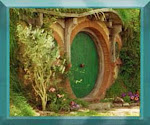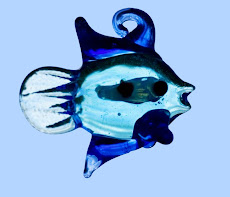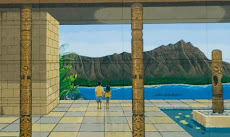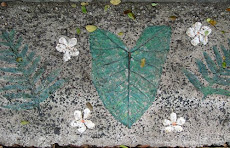|
|
| |
| (Many Paths) | ||
| An Online Newsletter Celebrating Native America | ||
| March 9, 2002 - Issue 56 | ||
|
| ||
| An "Urban Indian" Finds His Culture and His Career | ||
| by Suzanne Westerly Canku Ota Correspondent | ||
| credits: Suzanne Westerly |
|
"We all sat around and listened to our grandmother tell stories, but she didn't know too much because her family wasn't from the reservation either, she was born in 1890 so everything was pretty messed up around then. Most of my Cherokee heritage was all kind of scattered and broken up, it wasn't like I came off the reservation. The Trail of Tears just sort of blew everybody to the wind, as far as my personal ancestry goes." "I think I knew I was Indian before I even knew I was Indian. I always had an interest in it. I didn't know anything about Cherokee culture, and living out here I didn't have anyone to go to who could really help me get a handle on it. But over the years, it's been a little bit here, a little bit there. I’ve run into a lot of dead ends. Some I can trace way back. Like one of my ancestors was Carolina Crow, she was from Memphis. Well that was all Chickasaw territory so I don't know if she was Chickasaw or if she was Cherokee who just moved over there. One of my uncles said that he was Cato which was that whole Mississippi area, and that is where Cato are now," he said. "My uncle told me things about my dad and his brother, and their father and his father and then it ends. I asked my Uncle, "'how come we can't find anything?' He told me, "'Because back in those days you didn't say anything. You just kind of disappeared, and there weren't any records. So, for us to look for birth records or death records, or anything - it just wasn't written down. Somebody died, you dug a hole, you did the ceremony. So we have a lot of dead ends and no one to go to to find out what happened," Michael said. When Michael went to college, he continued searching. "I went to the University of Arizona in Tucson, so I joined up with the Amerind Club; the American Indian club. We'd head out to the desert on Saturday nights and sing and then we'd get together at a friends house and drum and sing. And there were Pow Wows around Arizona, and I made my own regalia. It was a lot of work. I still do bead work but not like I used to," he said. "I did the Southern Straight Dance. I think Fancy Dance and Grass Dance is more for the younger guys, it's a lot of work," he said with a laugh. Becoming an Actor But acting found him again when someone from Hollywood spotted him in Tucson, and he found himself "cast as an extra out in old Tucson doing the New Maverick with James Garner and Jack Kelly. I thought, so this is what acting is all about, these guys are pros. James Garner, is a wonderful, wonderful man," said Michael adding, "It was a pilot that didn't get picked up." "Then I did Road House, and Next of Kin, two Patrick Swayzee movies; Deathwish 4, with Charles Bronson, and then I started doing a lot of independent productions." Native Americans In Film And Television (NAFATA) Michael felt the Caucus played a vital role for Native actors, and didn't want to see the meetings just fall apart. He had been doing plays over at the Autry Museum of Western Heritage with Native Voices, and remembered that Scott Kratz, the Assistant Director of Education at the Autry had offered a room at one time for Native American meetings or plays. So Michael asked, and Scott said "sure." It's difficult trying to organize alone so the meetings didn't really take off until Duane Humeyestewa (Hopi) started attending. They discussed “creating films, and having workshops; acting workshops, writing workshops, directing workshops,” said Michael. Reenergized, Michael and Duane co-founded Native Americans In Film and Television Alliance NAFATA. Michael Wise (Cherokee) and Duane Humeyestewa (Hopi) are the founding members of NAFATA, Native American Film and Television Alliance, established to serve as a resource outlet for the Native community involved in the film and television industry. They decided to open NAFATA up to actors who werenít in the Screen Actors Guild (SAG)ís Native American Caucus. Today NAFATA has a variety of categories, Michael explained, "the union actors and the non-union actors, writers, directors, producers and behind-the-scenes crew people as well. If somebody is interested in doing set design, or stunts, or wrangling, then what we'll do is we'll have different categories for these things on our web page. So we can get this out to the studios and make the studios aware of this group, our data base and web site so that they will be able to hire more Native Americans." Getting a film made. "It's difficult because there aren't enough resources. That is one of the reasons for developing NAFATA," said Duane. "One tangent of it will be a non-profit where we raise money from all kinds of sources to provide funding for filmmakers, actors, and writers so they can get an education. Help them get through school, provide grants, provide money to get the projects done. Because most of the Native writers and directors know that if they just had a couple thousand dollars to experiment, try a project just to see what would happen; they would love that," he said, with enthusiasm, "and that's the whole notion behind NAFATA. Giving people the opportunity." Seminars and Workshops are available are very reasonable rates. Michael and Duane feel strongly that there is a need for continuing education and so NAFATA members are aware of ongoing changes in the industry. "As the entertainment and information industries have evolved, so has participation in them by Native Americans. Today, more and more Native people work as writers, directors, actors, and technical personnel in film and television, and in new media resources such as the Internet (the Web)." The mission and goals of NAFATA are to promote a stronger presence of Native peoples in all the media, help protect Native artistic rights, and to strengthen skills, abilities and power as artists, through a collective presence and action. They also hope to share Native culture and heritage with the rest of the world through the voices of the dozens of members who comprise the Native American Film and Television Alliance. The above is a synopsis of the NAFATA web site which can be found at www.nafata.org and statements by Michael Wise and Duane Humeyestewa. And to find out about NAFATA to either become a member or to see their movie shorts, go to their website at www.nafata.com. For more information go to www.nafata.com. To find out more about Native Voices and the plays they put on, contact Scott Kratz at the Autry, 323-667-2000. |
|
| ||
|
| ||
| Canku Ota is a free Newsletter celebrating Native America, its traditions and accomplishments . We do not provide subscriber or visitor names to anyone. Some articles presented in Canku Ota may contain copyright material. We have received appropriate permissions for republishing any articles. Material appearing here is distributed without profit or monetary gain to those who have expressed an interest. This is in accordance with Title 17 U.S.C. section 107. | ||
| Canku Ota is a copyright © 2000, 2001, 2002 of Vicki Lockard and Paul Barry. | ||
|
|
| |
| The "Canku Ota - A Newsletter Celebrating Native America" web site and its design is the | ||
| Copyright © 1999, 2000, 2001, 2002 of Paul C. Barry. | ||
| All Rights Reserved. | ||
Thank You


 "My family moved here in the 50's after WWII," said Michael Wise, who grew up in Los Angeles. They didn't talk about their Cherokee culture. He only knew his mom was French and English, and that his dad came from New Mexico after leaving Oklahoma. "Dad's side didn't really pay too much attention to their heritage, possibly because if you did say you were Indian you would be pushed aside or worse. I didn't really know anything until my grandmother came and lived with us and told us that we were Indian. I was about 12. She shared the culture with my two brothers and myself," Michael remembered.
"My family moved here in the 50's after WWII," said Michael Wise, who grew up in Los Angeles. They didn't talk about their Cherokee culture. He only knew his mom was French and English, and that his dad came from New Mexico after leaving Oklahoma. "Dad's side didn't really pay too much attention to their heritage, possibly because if you did say you were Indian you would be pushed aside or worse. I didn't really know anything until my grandmother came and lived with us and told us that we were Indian. I was about 12. She shared the culture with my two brothers and myself," Michael remembered. Michael started acting in grade school and continued through college. Thinking he should study anthropology or geology or something," he did.
Michael started acting in grade school and continued through college. Thinking he should study anthropology or geology or something," he did.





























